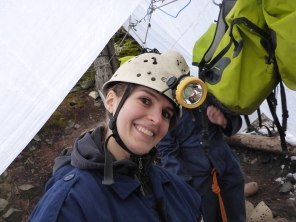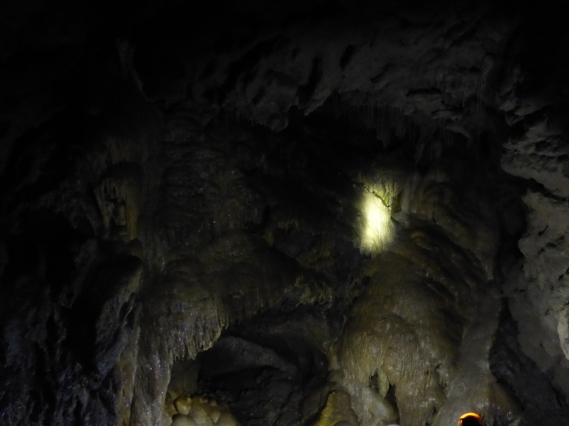Happy Birthday Danny! This past weekend we celebrated Danny’s birthday with a surprise trip to Canmore. I wanted to plan a surprise and what better spot than the mountains: Danny’s favourite place in Alberta.
I was Googling spring activities around Canmore and Kananaskis and came across Canmore Cave Tours. I booked the Adventure Cave Tour in Rat’s Nest Cave which was approximately six hours long. We’ve been on a couple other cave tours, but they involved idly walking along a path. This tour was so much more than that.

We arrived in Canmore and made our way to the tour office. We were suited up in all the most stylish cave wear: ill-fitting coveralls, grabby gloves, slightly padded knee pads, hardhat with light attached, climbing harness, rope with carabiners and a waterproof bag to share between two people. We brought our own hiking boots which definitely provided enough grip for the cave.
Our group was made up of eight people and one guide which is the maximum size they put together typically. We packed our gear in our bags and made the 30-40 minute hike up to the cave entrance. The hike was fairly steep, but we went slow enough that it didn’t seem bad.
Rat’s Nest Cave was carved out of limestone during the last Ice Age. Limestone is a sedimentary rock which is soluble in water and weak acids. During the Ice Age the entire valley was covered by a glacier and the melting water flowed through the limestone forming the cave/karst landscape. Below is a map of the section of the cave that we explored with Canmore Cave Tours. The red and green lines show the path that we took.


At the cave entrance we suited up under a tent and headed in. The cave has a gate and lock to prevent randoms entering, however, you are able to get the code from the tour company and go in solo if you are an experienced spelunker.
At the entrance you learn where the cave gets its name. There are ledges with numerous Bushy-tailed Wood Rats’ (part of squirrel family) nests. There is also quite a stench of rat poop at the entrance which smells vaguely like a skunk. If you look down there is a deep chute which apparently has numerous bones at the bottom. Looking up at the walls there are paint markings from an Aboriginal group that are dated approximately 2,000 years ago.


We started our crawl down into the cave using a rope system, sliding on our butts and crawling a bit. It opened up into a larger area and we were able to stand up. There was a ledge that had some bones on it. The rats brought the bones to this ledge to eat for the nutrients.
The guide asked if anyone had rappelled before and Danny was volunteered to go first. He moved to the front of the line and we continued along a passage that got quite tight. There was plenty of room lengthwise. As you moved down you were laying at an incline with the rock inches from your face. Danny was set up with the belay system and started the descent into blackness.
We rappelled down 18 m into a large chamber. This portion definitely took the longest to get through everyone. It was so much fun though! You are in control of lowering yourself and can go as fast or slow as you wish.
We crawled into the cave further and into another chamber. We were invited to do an extra squeeze if desired. Not everyone had to do it and only half of us did. We went on our bellies and used our arms to pull us through a small opening into a separate room. I fit pretty well through, but my booty was a bit too big and had to squeeze under the rock.
We rejoined the others and moved on to the Laundry Chute. It starts with a passageway between two rock faces that goes straight down approximately three feet to a ledge. The first picture below shows the entrance to the Laundry Chute. The second picture shows me coming down the first portion. Danny is taking the picture from the ledge. You could use our legs against the rock to lower yourself down slowly so that you don’t land on the person in front of you. Once you land on the ledge you aim your feet down the chute. The chute is at a slight incline and you slide your butt down slowly. After about four feet it takes a slight turn and you continue sliding down for another ten feet until you end on your back and come out into a larger chamber. The third and fourth pictures below are us inside the chute.




We moved through some more ropes to help us move down further into the cave. We stopped to view some soda straws that were hanging from the roof. Soda straws are hollow tubes that grown when water moves slowly through cracks in the rock. Some of these were over a thousand years old. They are considered to be one of the fastest growing things in the cave.
We then moved on to another optional squeeze. This one involved a little bit more work. It was similar to the first one, however, it was a bit longer and narrower. We went in on our stomachs to start. Then had to flip over onto our backs, raise one arm up through a crack and wiggle our way through. Sometimes we couldn’t quite use our arms so we had to just use our feet. I found this one a lot harder to get through.The interesting part of this squeeze was that we went between a fault in the rocks. In the below pictures I am between the two rock faces. This fault would have happened two million years ago when the area was still geologically active.



Next we moved into the Grotto, the lowest chamber in the cave. It is full of stalactites and stalagmites. There was also a pool of water there into which divers had gone previously. They moved through a series of different air bubbles and pools. They eventually could not go any further, but were able to put dye into the water. They discovered that the water from the Rat’s Nest Cave eventually exits into the Bow River.
From the Grotto we began our descent back up and out of the cave. It’s amazing how little we remembered about where we had been. We would enter a chamber and the guide would ask if we knew which way to go. I honestly had no clue and at some points could not even see the right exit point.
We stopped in one of the chambers on the way out and the guide made us turn off our lights. The dark was all encompassing. We were told a story about a five day cave tour our guide had done. He related that the first day in the cave he stopped for lunch not realizing that 14 hours had already passed. He also told of how one night he woke up to check his watch to see what time it was and reached down to zip his sleeping bag. He woke up nine hours later and hadn’t zipped his sleeping bag. His stories were to show that humans are poor at understanding the passage of time without the sun as a reference. Following his stories, everyone just let the silence surround us. It was amazing how silent it was. You could hear nothing. It made me realize the appeal of caving. There is something raw about caving. It’s the last great wilderness where you can go and feel like a true explorer.
We continued our way up to the cave entrance. The fresh air and sunlight were thankful experiences after being in the dark, dustiness of the cave. We removed our caving gear and hiked back down.
This was an experience that I would suggest to all of my family and friends. It was a bit pricey, but the Adventure Tour made me feel like a true spelunker rather than a tourist. I’ll leave you with some pictures from inside the Grotto.
M



Very interesting a great adventure.
LikeLike